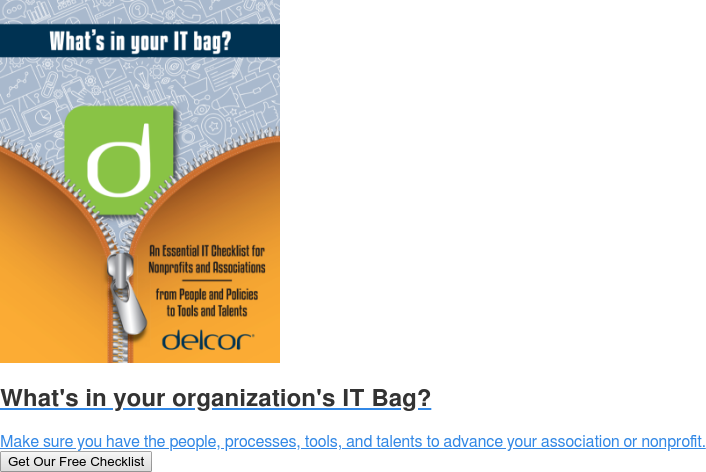In many areas of life, we’re digital first. And increasingly so.
Ask someone how they met their partner. At least half of them will say Match or Tinder, depending on their age. We buy our clothes, supplies, groceries, books, and movies online. We’re in and out of our online shopping cart every week—or every day.
Your organization is a digital experience for many members.
Some do go to in-person events. Many more depend on you for information, education, and connections they can access online, as well as products, services, and registrations they can buy online. In that way, current and prospective members are perusing your website, social media, app, online community, etc., to fill their digital shopping carts, too.
 This digital world requires your association or nonprofit to ask some unique questions:
This digital world requires your association or nonprofit to ask some unique questions:
- Do you have the right people in the right roles taking the right strategic decisions to provide a meaningful digital experience to your members and website visitors?
- Does your team have the necessary digital skills to enact that strategy?
- Are you providing the right digital tools to help staff and members succeed in their quest?
- Do you have the right digital plans and policies in place to deliver a rewarding digital membership experience?
These questions will help you determine whether you have the right stuff in your association’s “digital shopping cart”—or, in keeping with the theme of this series of posts, in your “digital IT bag.” Let’s take a closer look at your contents.
People
The organizational roles described below aren’t so unusual in for-profit organizations, but the organizational charts of many associations and nonprofits still follow a traditional departmental model: Marketing, Communications, Membership, Meetings, IT, Finance, HR, etc. While it’s important to have those areas covered, almost everything we do in the modern workplace has a digital component.
In my experience working with various associations on staff and in a consulting role, I’ve found that digitally-innovative organizations don’t follow the traditional departmental model.
Hire these people to advance your digital IT maturity:
Digital strategy leader: The head of digital strategy oversees content teams, creative positions, and web teams. They also work closely with the heads of data analysis and IT.
The digital strategy leader is responsible for developing, overseeing, and sharing throughout the organization these digital initiatives:
- Integrated marketing strategy
- Content strategy
- Website strategy (or website editorial mission statement)
- Communication strategy
- SEO strategy
The development of any digital strategy begins with analyzing your organization’s mission, vision, and strategic plan. Surprisingly, some associations and nonprofits still don’t have a documented strategic plan. An organization’s strategic goals, as defined in the strategic plan, guide the development of digital strategies—meaning the organizational perspective is critical to your digital success.
Dedicated project managers: A digitally-innovative organization also has dedicated project managers (PMs) within the digital strategy team. These PMs ensure that staff and vendors are producing deliverables on time and meeting project goals.
Governance staff: Most mid- to large-sized associations should have someone overseeing a content governance strategy, especially if you have a content management system (CMS), web team, and workflow in place for content creation.
Social media is another area requiring governance. The person overseeing social media governance works with the individuals responsible for the messaging, engagement, monitoring, and data analysis of social media channels. In fact, a governance model should be in place for all types of communication with members and the public, whether it’s email, phone, websites, private community, or in person.
Staff responsible for execution and analytics: Digitally-innovative organizations regularly produce fresh digital content that appeals to their defined target audiences—whether through digital interactives, infographics, mobile apps, or online journals. These organizations take risks with their content and, in many cases, gain recognition and win awards for innovation in their industry.
 You need people—internal or vendor staff or external contractors, freelancers, or agencies—to develop content and execute digital tactics. The necessary roles and responsibilities will vary by organization, since different strategies and audiences require different tactics, but they could include:
You need people—internal or vendor staff or external contractors, freelancers, or agencies—to develop content and execute digital tactics. The necessary roles and responsibilities will vary by organization, since different strategies and audiences require different tactics, but they could include:
- Market research
- Content and campaign creation
- SEO
- Content distribution via website, email, social media, mobile apps, digital and print publications
- Analytics
IT team: Digital marketing and communication teams are usually the biggest buyers and users of technology in an organization. They work closely with the IT team on the requirements, selection, implementation, and maintenance of technologies that support their digital mission.
Internal customers: Staff in traditional business departments (membership, meetings, professional development, and advocacy) rely on the digital team’s expertise when planning and executing their own marketing and communication campaigns.
Technology vendor partners: The people behind the tools you use are critical to your team’s success. They’re a deep source of information about how other organizations are leveraging their technology.
External customers: Finally, we arrive at the people who matter most: your members, customers, and constituents. Everything you do revolves around them—no one else, not even your board. Strategy and tactics begin with your external customers in the form of personas. Then, you need their feedback on what you’re doing so you can improve the digital experience, services, and products your association provides.
Policies
You’ll find many creative types working on digital initiatives since they’re the idea and content creation people. But the people on your digital team should also be sticklers for plans and policies (and proofreading!).
Documented plans: Strategies that live in someone’s head are rarely successful. You must document strategy, starting with your content strategy—your plan for creating, delivering, and governing useful content. Every strategy should include measurable goals so you can determine how well your tactics are working.
Crisis communication plan: You must be prepared for anything. Develop a plan for communicating with different audiences about any number of possible crises. Make sure your communication tools—as many technical platforms as possible, including social media—will work when needed. This plan should specify which staff or volunteer is responsible for specific tasks.
Style guide: Establish guidelines for all staff that ensure consistency in voice and branding. Your style guide should cover print as well as digital.
Governance policies: Simple tasks and complex decisions are guided by governance policies. These policies ensure that your use of technology, like your website and social media, is aligned with business goals and your resources are used efficiently.
Talents
The list of skills needed for digital initiatives is long. But, remember, you can outsource many of these skills, especially the ones you only need occasionally.
Persona development: Understand your target audiences—what they want and the best way to provide what they need.
Strategy development: Know how to develop a strategy with measurable goals.
Strategic counseling: Be ready to advise business departments on communication and marketing plans.
Content creation: Create, edit, and review content for any variety of print and digital publication, including audio/video production.
Marketing: Augment your team with experts in SEO, market research, A/B testing, and campaign development.
User experience (UX): Make sure website and mobile users have a satisfying experience and can accomplish efficiently what they need to do.
Data analytics: Web and email analytics help you measure success and guide decisions on marketing and content.
Training: The digital team coaches staff, facilitating compliance with style guides, governance plans, and other policies. They also train colleagues on the CMS, social media, and other digital platforms.
Tools
Software: The digital team needs the appropriate tools to do their jobs, for example:
- Email marketing software
- Marketing automation software
- CMS
- SEO tools
- Social media platforms
- Analytical tools
- Content creation and digital publishing software
- Video/audio editing tools
- Integrated databases, like the AMS or CRM
Market research: Your digital strategy is guided by research—from old-fashioned telephone interviews to website feedback, focus groups, surveys, polls, user testing, and data analytics.
Image resources: Digital teams rely on a variety of sources for images, including Creative Commons sites, stock photography sites, and amateur (staff and members) and professional photographers.
The competition for eyeballs and attention is fierce.
Your members, customers, and prospects have many options on where to spend their online time and where to fill their digital shopping cart. By stocking your digital IT bag with the right people, policies, talents, and tools, you’ll gain an advantage in ensuring your digital properties are ‘the place to be,’ keeping constituents coming back for more.

